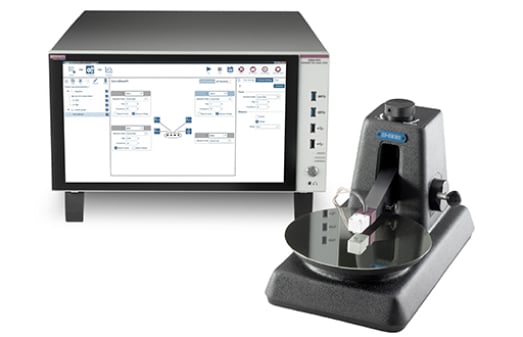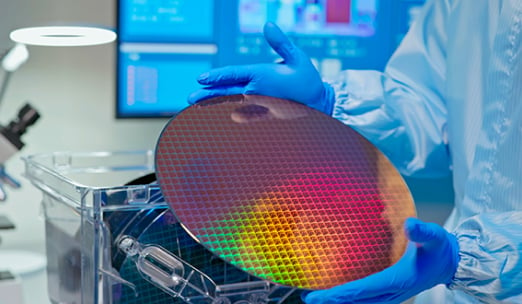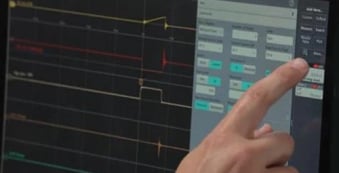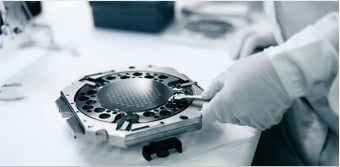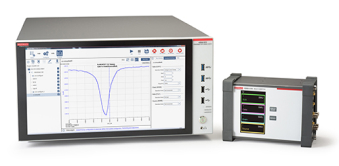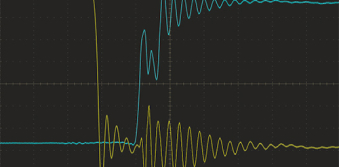お問い合わせ
ダウンロード
マニュアル、データシート、ソフトウェアなどのダウンロード:
フィードバック
エレクトロニクス革新における精度と信頼性の確保
技術の進歩、市場需要、政府の政策による、ほぼ毎日のブレークスルーのおかげで、世界中で半導体開発のペースが加速しています。私たちは、仕事、レジャーなど、生活のほぼすべての側面で半導体に依存しています。これらの電子機器の信頼性を定量化し、保証することは極めて重要です。半導体テストは、半導体の世界における材料、デバイス、システムの各レベルでの信頼性と性能を確保する広範なプロセスです。
テクトロニクスの包括的な半導体テスト・ソリューション
テクトロニクスは、設計者、検証エンジニア、製造者のニーズに合わせた幅広い半導体テスト・ソリューションを提供しています。ケースレー計測器は、ウエハからダイ、パッケージ・デバイスまで、デバイス特性の検証に優れた精度を提供します。EA Elektro-Automatik 電源は、次世代パワー半導体のテストに必要な高電力を供給します。そして、テクトロニクスのオシロスコープと信号源は、高速データ通信においてチップ設計者が進歩を遂げるのに役立ちます。半導体産業のグローバルな性質を考えると、テクトロニクスのようなグローバルなカバレッジを持つベンダーを選ぶことが重要です。
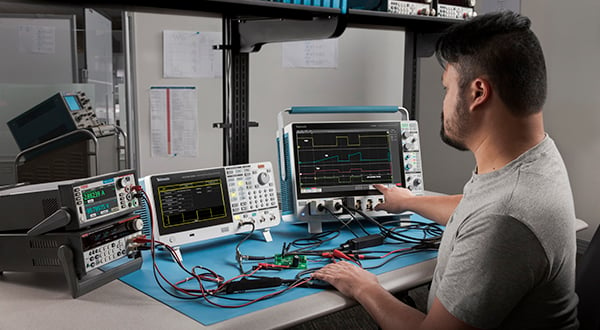
材料試験
パワー半導体業界における材料試験は、炭化ケイ素(SiC)や窒化ガリウム(GaN)などの材料の検査を含みます。それらの材料の固有の特性を理解するために重要なこの試験は、パワー半導体の製造において重要な役割を果たします。材料試験は効率的で信頼性の高い電子デバイスの開発に貢献し、エレクトロニクス産業の未来を形作ります。テクトロニクスが提供する材料試験の種類については、以下をご覧ください。
デバイス試験
パワー半導体業界におけるデバイス試験は、半導体デバイスの機能性、性能、信頼性を評価する重要なプロセスです。この試験は、半導体デバイスが電子製品に組み込まれる前に、必要な性能、信頼性、品質基準を満たしていることを確認します。デバイス試験には様々な技術が含まれ、その一つがI-V特性評価で、パワー半導体における電流と電圧の関係を理解するための基本的な方法です。テクトロニクスが提供するデバイス試験の種類については、以下をご覧ください。
システム・レベル・テスト
パワー半導体業界におけるシステム・レベル・テストは、システムのコンテクストの中で半導体デバイスの機能性と性能を確認する包括的なプロセスです。このテスト方法は、ウエハ・プローブやパッケージ・テストの段階では検出できない設計上の問題を特定できるため、ますます重要になってきています。システム・レベル・テストにより、数百万個のチップを高速で並行してテストすることが可能となり、最大限のテスト・カバレッジを確保しながらスループットを向上させることができます。半導体の微細化が進み、チップやパッケージにより多くの複雑性が組み込まれるにつれ、このテスト・アプローチは不可欠になってきています。
半導体テストに関する資料
半導体テストの段階
半導体テストは、半導体デバイスの製造において、最終製品が要求される仕様を満たし、高品質であることを保証する重要なプロセスです。テスト・プロセスは通常、ウエハ・テスト、パッケージ・テスト、最終テストなどのいくつかの段階に分かれています。

ウエハ・テスト
ウエハ・テスト(ウエハ・ソートまたはウエハ・プロービングとも呼ばれる)は、半導体テストの最初の段階です。個々のダイに切断される前の半導体ウエハ自体に対して実施されます。ウエハ・テストの目的は、早い段階で欠陥や不良を特定し、無駄を減らし、歩留まりを向上させることです。ウエハ・テスト中、プローブ・カードを使用してダイのパッドと電気的に接触させ、ウエハ上の各ダイの機能性がテストされます。テクトロニクスは、ミッション・クリティカルなデバイスの完全なウエハ・テスト・サービスを提供しています。そのサービスには、4インチ、6インチ、8インチ、12インチ(100mm、150mm、200mm、300mm)のアナログ、デジタル、ミックスド・シグナル・テストが含まれます。
ケース・スタディ:ウエハ・テスト
半導体製造施設のエンジニアとして働いているところを想像してみてください。新しいシリコン・ウエハのバッチを受け取り、それらをテストするのがあなたの仕事です。まず、ウエハをウエハ・プローバに装填します。これは各ダイがプローブ・カードの下に位置するようにウエハを自動的に配置できる装置です。プローブ・カードが下降し、ダイのパッドと接触します。その後、装置はダイの機能性を確認するための一連の電気テストを実行します。ダイがこれらのテストのいずれかで不合格となった場合、不良品としてマークされ、ウエハが個々のダイに切断された後に廃棄されます。

パッケージ・テスト
ウエハが個々のダイに切断された後、ウエハ・テストに合格したダイはパッケージ化されます。パッケージ化されたダイは、パッケージ・テストまたは最終テストとして知られる別のテストを受けます。このテスト段階はより包括的で、パッケージ化されたチップを様々な条件下でテストし、指定された電気的、機械的、熱的性能基準をすべて満たしていることを確認します。パッケージ・テストには、速度、電力、漏れ電流のテストが含まれます。テクトロニクスは、パッケージが流通と保管の厳しい条件に耐えられることを確認するためのパッケージ・テスト・サービスを提供しています。
ユース・ケース:パッケージ・テスト
今度は、パッケージ・テスト部門にいるとします。ウエハ・テスト部門からパッケージ化されたダイを受け取ります。あなたの仕事は、これらのパッケージ化されたチップが実世界での使用に準備できているかを確認することです。チップをテスト・ボード上のテスト・ソケットに装填します。テスト装置は、チップが意図したアプリケーションで直面する条件をシミュレートする一連のテストを実行するようプログラムされています。これらのテストには、チップの速度、消費電力、パッケージに漏れがないかどうかの確認が含まれます。これらのテストに不合格となったチップは廃棄されます。
最終テスト
半導体テストの最終段階は、システム・レベル・テストまたはアプリケーション・テストです。この段階では、パッケージ化されたチップが、実際に使用される環境に類似したシステムでテストされます。これにより、チップが実際のアプリケーションで正しく機能するかどうかを確認できます。テクトロニクスは、部品やモジュールが要求される性能レベルで動作することを検証するIC パッケージ・テスト・ソリューションを提供しています。
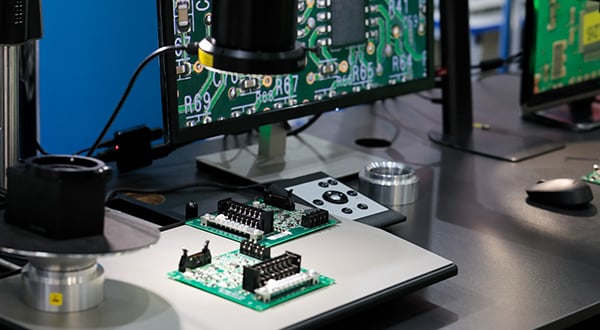
ユースケース:最終テスト
最後に、システム・レベル・テスト部門での作業となります。ここでは、チップは単独ではテストされません。代わりに、実際に使用される環境に類似したシステムに配置されます。例えば、携帯電話、自動車の電子システム、またはデータセンターのサーバーなどです。システムの性能を監視し、チップが意図された環境で期待通りに動作することを確認します。チップがこれらのテストに合格すると、顧客への出荷準備が整います。結論、半導体テストは半導体デバイスの品質と信頼性を確保する厳密なプロセスです。半導体テストにより、不良チップを特定して排除し、高品質なデバイスのみが市場に出回ることを保証します。
高度な半導体テスト技術
- DC パラメトリック・テスト : このテストは、さまざまな直流(DC)条件下での半導体の挙動を評価します。DCパラメトリック・テストは、漏れ電流、しきい値電圧、飽和電流などのパラメータを測定し、デバイスの性能と安定性を評価する上で重要です。
- AC パラメトリック・テスト: このテストは、異なる周波数の交流(AC)に対する半導体の応答を評価します。AC アプリケーションで使用されるデバイスにとって重要で、さまざまな動作条件下での性能維持を確認します。
- 機能試験: この包括的なテストは、半導体が意図した機能を正しく実行することを検証します。トランジスタの論理動作の確認や、ダイオードが電圧を正しく制御することの確認が含まれます。
- バーンイン試験: この長時間のテストは、半導体を極端な条件にさらして経年劣化を加速させます。これにより、製造者は初期不良を特定し、全体的な信頼性を向上させることができます。
- 静電気放電(ESD)試験: ESD試験は、日常環境で一般的な静電気の突然の放電に対する半導体の脆弱性を判断する上で重要です。
- 熱特性評価: このテストは、半導体の放熱性能を評価し、過熱を防ぎ、長期的な信頼性を確保するための重要な要素です。
- 機械的特性評価: このテストは、半導体の物理的な耐久性を確認し、動作中や輸送中の振動や衝撃などの機械的ストレスに耐えられることを確認します。
- X線分析: 非破壊的で洞察に富むX線分析は、半導体層の内部構造や、亀裂やずれなどの隠れた欠陥を明らかにします。
- 走査型電子顕微鏡(SEM)分析: SEMは半導体表面の高解像度イメージングを提供し、顕微鏡レベルでの表面欠陥や形状を検出できます。
- 透過型電子顕微鏡(TEM)分析: TEMは半導体の内部構造をさらに詳しく観察し、材料特性を理解する上で重要な原子レベルの詳細を明らかにします。
- 原子間力顕微鏡(AFM)分析: AFMは表面分析に使用され、三次元的な表面プロファイルを提供します。デバイス性能に影響を与える可能性のある微細な表面の不規則性を検出できます。
- 時間領域反射(TDR)解析: TDRは、電気信号の反射を測定することで、半導体パッケージと相互接続の完全性を分析するために使用されます。
- レーザ・ボルテージ・プロービング(LVP)試験: LVPは、集束レーザーを使用して半導体表面に電圧コントラストを作り出し、顕微鏡レベルでの機能的欠陥を特定するのに役立ちます。
- 磁気特性評価: このテストは、磁気センサやメモリ・デバイスで使用される半導体に関連し、磁場への応答を評価します。
- 高周波(RF)試験: 無線通信用の半導体において、RF試験は現代の通信ネットワークで使用される高周波信号を扱えることを確認します。
- 雑音指数測定: これは半導体がシステムに導入するノイズ量を測定し、高性能および精密アプリケーションにとって重要です。
- 電源ノイズ試験: このテストは、電源からのノイズが半導体に与える影響を評価し、変動する電力条件下でデバイスが確実に動作することを確認します。
- シグナル・インテグリティ評価: この重要なテストは、半導体が歪みや損失なく信号を送受信できることを確認し、デジタル・アプリケーションでのデータの完全性にとって重要です。
- 電磁両立性(EMC)試験: EMC試験は、消費者向け電子機器にとって重要な側面である、半導体が意図された環境で電磁干渉を引き起こしたり、それに屈したりすることなく動作できるかどうかを評価します。
半導体テストに関するよくある質問
半導体テストとは?
半導体テストとは、欠陥を特定し、機能性を検証し、業界標準への準拠を確保するためにチップを評価することを指します。半導体テストにより、チップが様々なアプリケーションで完璧に動作することを保証します。
半導体テストが必要な理由は?
製造プロセスで欠陥が生じる可能性があるため、テストは不可欠です。これらの問題を特定し修正することで、チップが品質基準を満たし、正しく機能することを確保します。
半導体テストの種類は?
- 機能テスト:チップが意図された機能を実行するかを検証します。
- 構造テスト:製造エラーに起因する欠陥を明らかにします。
- パラメトリック・テスト:特定の電子特性(例:電流と電圧レベル)を測定します。
自動テスト装置(ATE)とは?
ATEは、1つまたは複数のデバイスを同時にテストする高度なテスト・ツールです。ハードウェア、ソフトウェア、シグナル・ジェネレータ、テスト・プローブが含まれます。ATEは半導体生産中の効率的なテストを確保します。
ATEの仕組みは?
- ハードウェア:複雑な電子計測と刺激デバイスを含みます。
- ソフトウェア:データ・フローを制御し、異なるデバイス用の独自のテスト・プログラムを作成します。
- テスト・ツール:データと刺激信号の送信を管理します。
- テスト・プローブまたはハンドラ:テスト対象のデバイスと相互作用します。
半導体テストで使用されるテスタの種類は?
- ブーリアン・テスタ:デジタル論理を評価します。
- メモリ・テスタ:メモリ部品を評価します。
- アナログ・テスタ:アナログ回路を分析します。


